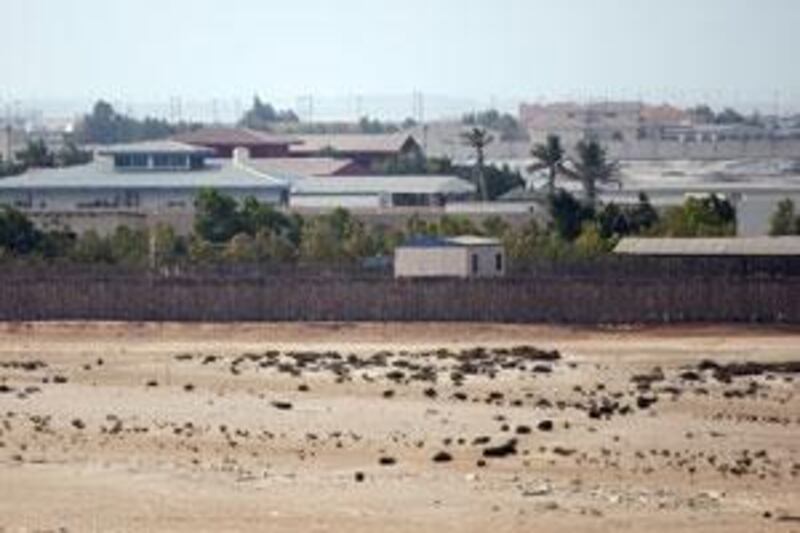Abu Dhabi // Guidelines are being drawn up to protect Al Gharbia's beach properties from rising sea levels as planners admit to "serious concern" over the vulnerability of unchecked development. Abu Dhabi's Urban Planning Council (UPC) estimates that property and infrastructure valued at US$400 million (Dh1.4 billion) now in place would be put at risk by a half-metre rise in sea level.
The amount of development is expected to rise exponentially as construction grows in line with the Abu Dhabi 2030 plan. While many building projects around the capital had been planned with the help of international experts and consultants, using "prudent" measures to mitigate the effect of climate change, smaller "ad hoc developments" on the coast were at risk, said Neil Mallen, the UPC's planning manager for the environment.
"The areas that we are particularly concerned about are those out of the city, where you are getting smaller-scale developments, like in the Western Region," he said. "In some areas you have a large number of private villas on the waterfront where you don't have a sea wall to protect them. With rising sea levels, there's the potential in low-lying areas for more frequent and more severe flooding to occur over time, and that could result in property damage or health risks."
Planners are already working to extend the Coastal Development Guidelines, published this week, to include stipulations that will help to protect against the effects of climate change, such as some coastal buildings having to be set back from the sea. "For the UPC it's a high priority," said Mr Mallen. "We are working on a series of regulations that will help ensure that new developments are undertaken in a responsible manner, and there will be remedial and mitigation measures for existing developments.
"We've resisted the temptation to come up with a simple universal 'setback' regulation, because it depends on the shoreline, the rise of the land, the land use. "Because there's a fairly complex range of factors it's hard to say exactly what we will come up with, but our objective will be to ensure public health and the safety of property." The guidelines divide coastal land from Al Dhabiya island, just west of the capital, to Ghantoot into zones for particular land use.
They do not include Al Gharbia or regulations to protect property from the effects of climate change, but Mr Mallen said both would be covered by the end of next year. "The final version of the guidelines will have more to do with climate change and predicted sea-level rise, and address the risk that is posed," he said. Private villas and beach houses dominate much of the coastline west of Abu Dhabi to Silah at the Saudi Arabian border. They vary from simple beach chalets to elaborate mansions.
"There's certainly been a massive investment in development on relatively low-level land and it's a concern," said Mr Mallen. Major Hamdan al Mansouri, a police officer, has a "chalet" on the beach 10km outside Al Ghuwaifat. Like many such houses, it is given to him by the Government on a temporary basis. "It's directly on the beach, just a few metres from the sea," he said. "I've never been concerned about the sea rising. My family been living on the coast here for a long time - my father, my grandfather - and we've not seen a problem. In other places, near Abu Dhabi, there have been problems from flooding, but not here."
Mohammed Raouf, the senior environmental researcher at the Gulf Research Centre in Dubai, said there were also worries for Fujairah. Unlike most of the UAE's coast, which is relatively sheltered, Fujairah's waterfront is exposed to the open sea. "Owners are going to have to take necessary measures to adapt to sea-level rise and there will be a huge cost for this adaptation," he said.It was important for environmental impact surveys to be carried out ahead of any development.
Across the world, the sea is threatening coastal properties, causing insurers to increase premiums, or refuse to insure some properties altogether. "Anybody who builds on the ocean anywhere in the world is taking a risk," said Greg Acker, the UPC's senior planning manager. "You're on the edge of a very volatile body." A separate set of regulations, also expected to be released in late 2010, will address the fact that much of the coastline in more rural areas such as Al Gharbia is being used for residential waterfront development, when other uses are also necessary.
"Right now, you have long stretches of the coast where you have villas built, in some cases on permanently allocated plots," said Mr Mallen. "But in other cases, these villas were allocated for temporary use for a period of 20 years, and people have gone and built houses on them; some of them are really elaborate. "From a land use perspective they are using up long stretches of shoreline. "This document will say residential waterfront developments are appropriate here and here, but not there and there."
lmorris@thenational.ae






